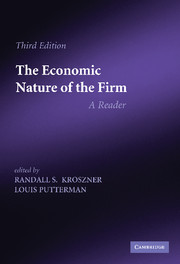Book contents
- Frontmatter
- Contents
- Editors' preface
- Reintroducing The Economic Nature of the Firm
- Part I Within and among firms: the division of labor
- Part II The scope of the firm
- Part III The employment relation, the human factor, and internal organization
- Part IV Finance and the control of the firm
- 19 Mergers and the market for corporate control
- 20 Agency problems and the theory of the firm
- 21 Theory of the firm: managerial behavior, agency costs, and ownership structure
- 22 Organizational forms and investment decisions
- 23 The rise in managerial stock ownership
- 24 Executive compensation as an agency problem
- 25 An economist's perspective on the theory of the firm
- 26 Ownership and the nature of the firm
- References
26 - Ownership and the nature of the firm
Published online by Cambridge University Press: 05 June 2014
- Frontmatter
- Contents
- Editors' preface
- Reintroducing The Economic Nature of the Firm
- Part I Within and among firms: the division of labor
- Part II The scope of the firm
- Part III The employment relation, the human factor, and internal organization
- Part IV Finance and the control of the firm
- 19 Mergers and the market for corporate control
- 20 Agency problems and the theory of the firm
- 21 Theory of the firm: managerial behavior, agency costs, and ownership structure
- 22 Organizational forms and investment decisions
- 23 The rise in managerial stock ownership
- 24 Executive compensation as an agency problem
- 25 An economist's perspective on the theory of the firm
- 26 Ownership and the nature of the firm
- References
Summary
Ownership and its components
The production of goods and services commonly requires a large variety of inputs, including financial resources, risk-bearing services, and decision making. Decision making is a necessary input because production takes place in real time, and relevant events, such as mechanical failures, technical innovations, or changes in market conditions, cannot be foreseen when agreements to undertake production are initiated. Financial inputs are required because it is usually worthwhile to employ techniques entailing a lag between the investment of resources and the completion of saleable products. Risk bearing is required when the realizable value of the products cannot be known with certainty at the time that costly effort, materials, and services of capital goods are used up.
In most business firms, decision-making rights are held by persons who are also financial risk bearers and suppliers of funds. The holders of these rights are known as the owners of the firm. Ownership refers to a bundle of rights that an economic agent is entitled to exercise over an asset. Its main components are the right of utilization, the right to the products of the asset, and the right to alienate or dispose of the asset and of these rights of utilization and return (Montias, 1976, p. 116; Ryan, 1987, p. 1029). The firm as an ownable asset is an entity that acts as a legal agent in the marketplace, entering into contractual agreements with other agents in order to produce and sell goods and services.
- Type
- Chapter
- Information
- The Economic Nature of the FirmA Reader, pp. 353 - 362Publisher: Cambridge University PressPrint publication year: 2009
- 5
- Cited by



